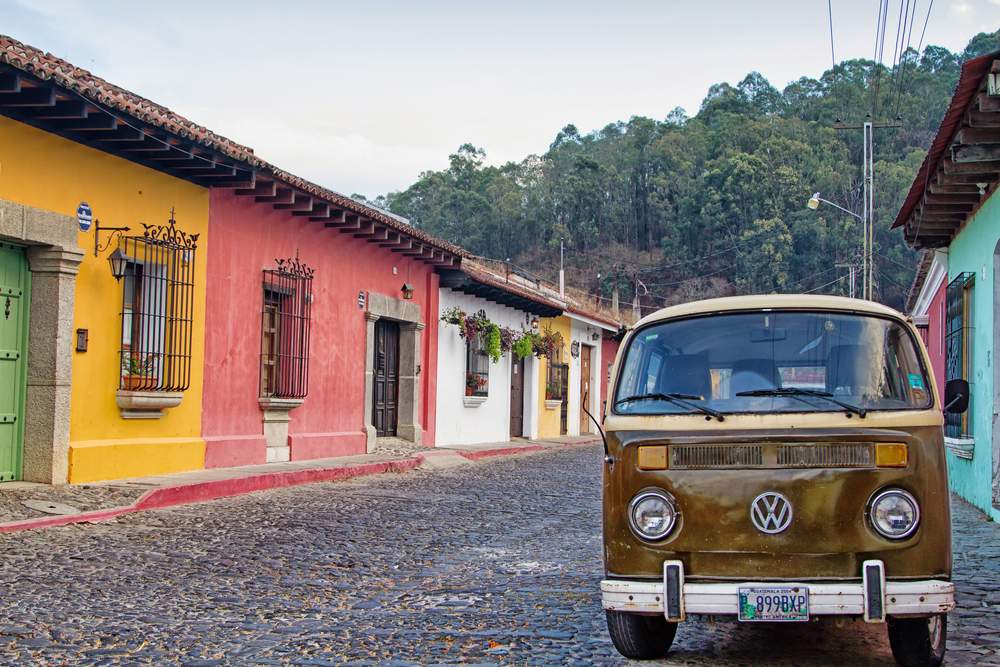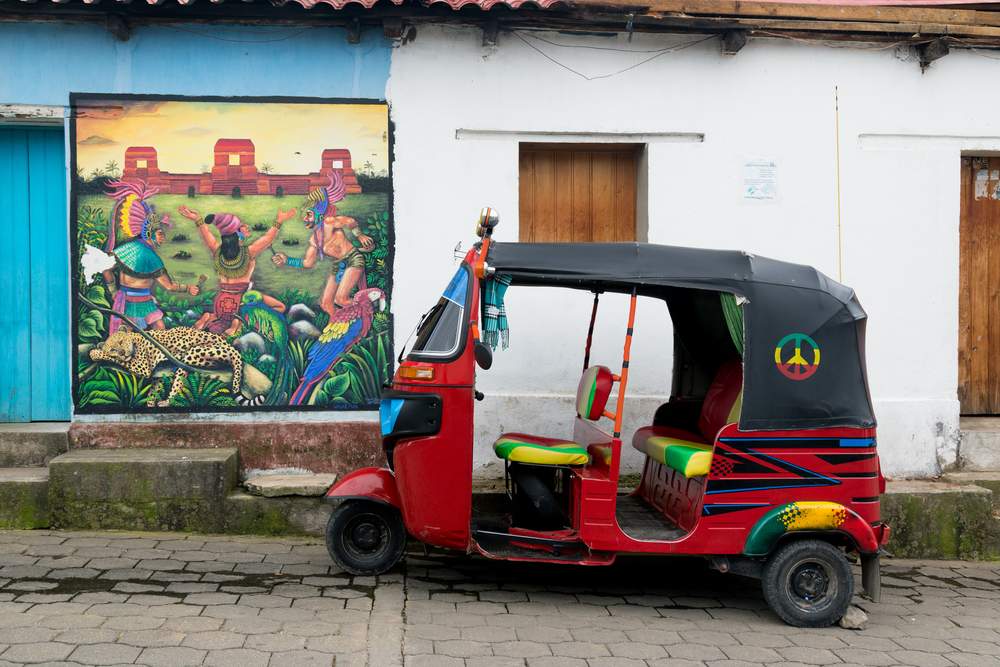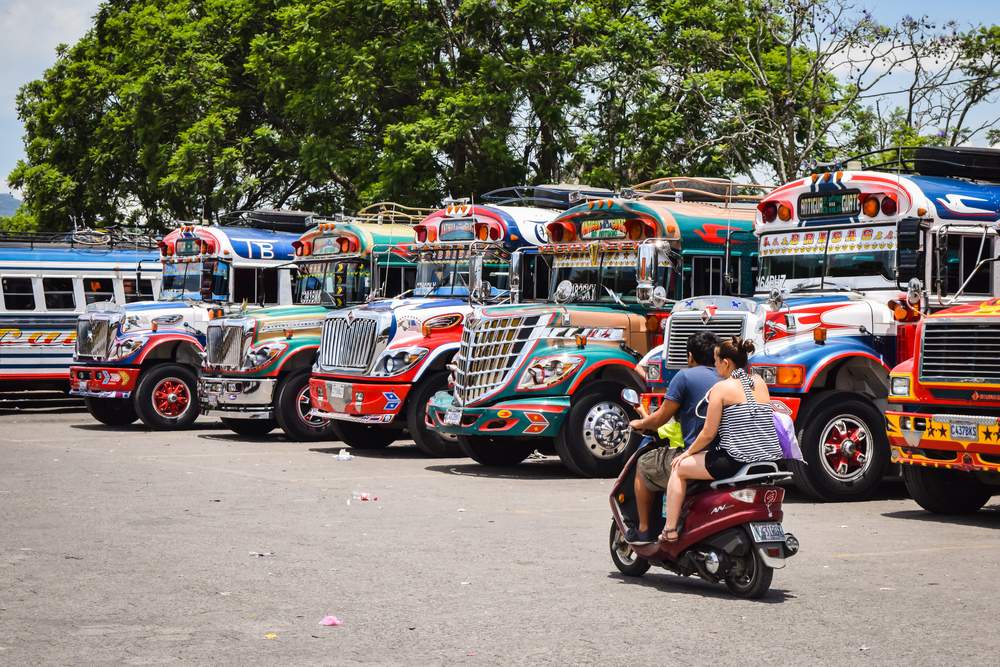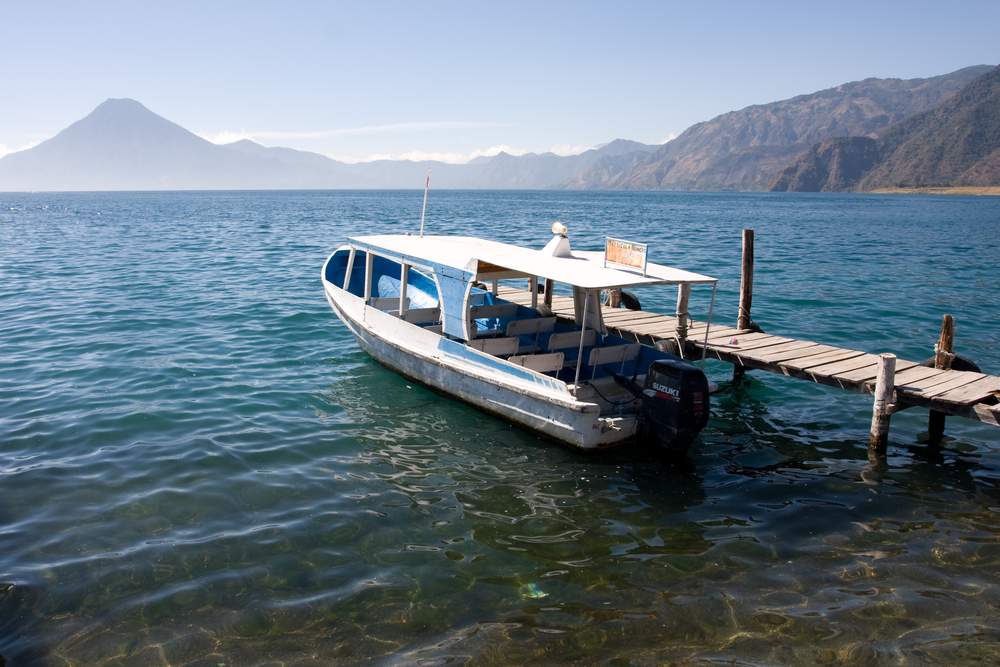Guatemala is one of those places that hits you like a wet sock in the face if you fly in and try to hit the ground running. It’s much nicer to drive the length of Mexico and ease into her a little bit. But if you can’t manage that, and you’re coming in hard, then overland travel is your next big hurdle.
Wondering what that looks like? I’ll break it down for you, from the easiest to the most challenging modes of transportation. Read all the way to the end for some logistical and packing tips to make it all easier.
Hire a Driver

Sometimes it’s cheaper
Sometimes it’s safer
You can go where you want
You don’t just get a driver
I have long-term relationships with our two regular drivers in Guatemala. I know their families, and they know mine. One of them took a week-long road trip into Honduras with us, and we had a blast.
To give you an idea of the price, our driver in Panajachel charges $100USD for a round trip from Lago de Atitlan to Guatemala City (the airport, or wherever you need to go. Our driver in Antigua charges $50 USD for a round trip between the airport and Antigua. I’m quite sure it could be done cheaper, but that price includes the decent tip we always give.
Collectivo
Be prepared for your luggage to be tied on top. Be sure you’ve taken everything valuable or susceptible to impact or water damage out of your bag in advance and carry that in a small daypack on your lap.
These are probably the safest way for tourists to travel, short of hiring a driver. That doesn’t mean you should blithely put your life in someone else’s hands, always take responsibility for your own safety and the security of your own stuff. Always. At home, abroad, everywhere.
To give you an idea of pricing, this past winter it was an average of 80Q (about 12 USD) for a seat on a collectivo between Antigua and Lago de Atitlan.
Bus
There are several ways to procure tickets, through local travel agencies (walk up) or through a connection at your hotel. I would recommend going directly to the bus station and sorting it out directly. You’ll get a better price (no middle man), and you’ll be very sure you’re getting the bus you think you’re getting.
These buses are an easy way to travel. If you’re headed to Tikal and don’t want to pony up for the more costly flight over and back, there is an overnight bus that leaves from Antigua, or Guatemala City and has you in Tikal in time to tour the ruins in the morning. You can take the bus straight back that evening, thus rolling your lodging and transportation costs into one and “saving” some money. That said, it’s a 12-hour bus ride, you’ll miss all of the good stuff traveling in the dark, and overnight busing is not my favorite sport. I’d recommend either taking the flight if you’re in a hurry or traveling more slowly, overland, taking several days to get there, enjoy the ruins and get back.
These big buses also run up into Mexico, and down into the countries further south, as far as Panama (expect to change buses). I don’t have updated pricing on these, and as there are several lines and multiple routes, it’s best to check it out on the ground.
Tuk Tuk

Tuk tuks are the way to get around in just about every town in Guatemala, no matter how small. Expect a two-tiered pricing system. Yours will be the more expensive price. When negotiating with these guys, never take the offered price. Always offer a third, or half, and work your way to a middle ground. With a smile. And don’t forget to tip, it’s good manners.
Expect to pay 3-5Q for a short local ride in Antigua or Panajachel, but remember that what you pay is highly variable. Get good at mental currency conversion!
Taxi
Personally, I never take cabs in Guatemala. They are too much hassle and I’d rather take a cheaper tuk-tuk, or hire a driver, but that’s just me.
Chicken Bus

Tips for riding a chicken bus:
ASK the destination before you get on the bus. Do not allow them to take your gear until you are very sure you know where it’s going. It will be loud, they’ll be in your face, it will feel high pressure and like there’s a big rush. There is not. Another bus will be along shortly. Don’t be pressured.
Check out the driver. Make sure he’s old enough to be able to drive and is sober, at the very least.
Be prepared for your gear to go on top. Pay attention to your gear at stops, to make sure it stays on the bus with you. The stops happen fast and it’s not unusual for the wrong bags to be tossed to the wrong people.
Carry your valuables on your body. Preferably inside your clothes, and don’t take them out. This is not the time for you to be taking pictures with your expensive iPhone through the bus windows.
Don’t ask the cost of the fare. There are no tickets, you just get on and sit down, a guy will come to collect the fare. Pay attention to what’s going on as the man passes through the bus collecting money. Pay what everyone else is paying. If it’s wrong, he’ll tell you. Only one time have I ever had a chicken bus salesman try to raise the price for me. If you look like you know what you’re doing, they’ll assume you know what you’re doing.
To give you an idea of the cost difference, a collectivo between Antigua and Panajachel costs about $12 USD. The same trip by chicken bus happens faster and costs just under $4 USD. You’ll change buses three times, at: Chimaltenango, Los Encuentros, and Solola. (in reverse going the other way). Don’t be afraid of chicken buses, they’re a great way to travel.
Flete
To catch a flete, either flag one down, or visit the “depot” which is really just a designated parking area, usually near the market or main square in any little town. Always ask the price before you get in and be prepared to haggle. When you’re ready to get out (if it’s not an organized stop in a town) pound on the roof of the cab and they’ll pull over. You’ll pay a portion of the agreed upon point to point fare and you’ll be on your own.
Fletes are the best way to get to really off the trail places that even chicken buses don’t go. They’re also great for short jaunts between towns.
No, it’s not hitchhiking. Yes, they’re somewhat dangerous.
Boats on Lago de Atitlan

The way to get around is on the lanchas, a system of water taxis that connect the towns around the lake. I wanted to include a few words on these boats because I’ve listened, quietly, to a lot of funny conversations (and some not so funny ones) on these boats over the years, in English and in Spanish, and sometimes in Mayan, which I do not understand, but not everything actually needs translation, if you know what I mean.
There’s a public dock in every town. There’s no hard and fast “schedule” for these boats, they do run regularly, every half an hour or so at most, frequency is often dependent on traffic. They stop running at dusk. Private boats can be hired after that, but you’ll pay a premium.
Morning rides will usually be calm and lovely. Afternoon rides may beat you to death. Plan accordingly.
Pricing is three-tiered
Long-term expats are paying another price. Unless you’re there at least six months and become a known entity to the drivers, you won’t get this price either.
Regular tourist price is you, and it’s still inexpensive, so stop complaining.
There is a fourth price… which I refer to as the “newbie tax.” If you’re foolish enough to ask, up front, what the price is for a boat ride, you’ll be told, and taken for a ride (not a boat ride, in case you were wondering). I’ve heard people be told that the price is 80Q when it’s 20. I’ve heard one traveler confidently tell another that the price is 30Q when it’s actually 15. As with chicken buses, pay attention to what other people are paying, or, ask someone who looks like a long-term expat what the price should be. Don’t ask the driver.
Panajachel to San Marcos: 20Q (10 to Santa Cruz, 15 to Jaibalito)
San Marcos to San Pedro: 10Q
Renting a Car
Driving in Guatemala is rather more analog than digital, which means that road rules, while they exist, are flexibly interpreted. If you don’t have experience driving in less than first world conditions, this is probably not the country to get your feet wet in. Also, be prepared to drive a manual transmission vehicle (stick) as automatics are harder to rent.
We drove our own van through the country a few years ago and got so turned around in the City that we had to hire a cab driver to lead us out of town. Yes, really. Adventures abound. Subsequently, we’ve rented cars in and around Antigua and Guatemala City and we no longer get lost… as often.
If you get into an accident expect people to want to negotiate on the spot, pay each other off and avoid getting the authorities involved. Rental cars are theft magnets so make sure you have secure off-the-street parking at night. And understand that this is not the cheapest, easiest or smartest way to travel in Guatemala. There are, however, reasons to do it, occasionally. May the force be with you.
Tips for Traveling Overland in Guatemala
Pay attention, and ask around. Ask people who look like they live there, not the guy with a loud mouth in your hostel who knows everything except the fact that he’s paid too much for every single thing.
Don’t take the first offer.
Negotiate hard, with a smile.
Tip generously.
If you’re hiring a driver, make sure you come to an agreement on price in advance. If you’re hiring him for a road trip, expect to pay hotel and food as well as parking costs for the driver. Treat him like a friend, not an employee and it’s very likely he’ll open some doors for you that aren’t on the car.
Be brave and travel locally. Getting yourself into the situation where you’re the only non-Guatemalan in sight is a sign that you’re getting off of the beaten path and you’re beginning to really travel instead of just tour in a place. Remember that the world is a wonderful place, people are, overwhelmingly, good and kind, and you almost never die!
Guatemala is a beautiful country, my favorite, in fact. I wish I could take you there myself, help you negotiate the crazy that is “Washington and Jefferson,” as we affectionately call the spaghetti bowl mess of a chicken bus exchange in Chimaltenango. I’d love to ride across the lake in the early morning and name the volcanoes that frame it for you. I’d love to laugh as you try not to fall out of the back of a careening tuk tuk for the first time. Do me a favor, and tweet me a picture when you go. It’ll make my whole day.
Learn more about overland travel and destinations in Central America below:
- 5 Reasons to Add overland Travel to Your Trip
- Overland Travel With Kids
- The Ultimate Guide to Travel in Central America
Photo Credits: Shutterstock.com, Milosz Maslanka /Shutterstock.com, Milosz Maslanka / Shutterstock.com, Joseph Mortimer /Shutterstock.com,Shutterstock.com /Shutterstock.com, Philip Mowbray.